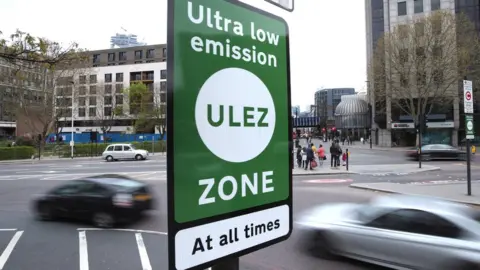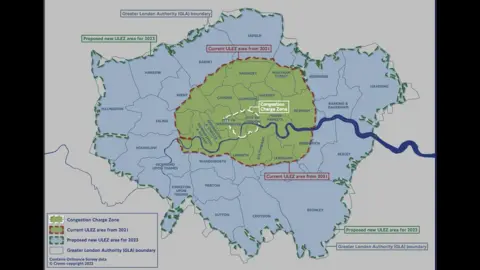ULEZ: Charges and fines raised nine-figure sum in 2022
 PA Media
PA MediaLondon's Ultra Low Emission Zone (ULEZ) generated more than £224m last year, official figures show.
Data obtained by the BBC has found that roughly a third of the money came from penalty charge notices (PCNs), with the rest from daily charge payments.
Transport for London (TfL) says the money is used to cover "set-up costs" for the ULEZ expansion and "running and improving" the rest of the network.
The zone will expand on 29 August, encompassing all London boroughs.
Through data obtained via a freedom of information request, the BBC has found ULEZ generated £224,633,003 in 2022, an average of £18.7m a month.
Money came in through two streams: daily charges and PCNs.
Any vehicle driven within the zone must meet ULEZ emission standards, or pay a £12.50 daily charge. Those drivers who fail to pay up will receive a PCN of £180, although this figure is reduced to £90 if paid within a fortnight.
Last year, £151.3m was generated through daily charges, with £73.3m in PCNs.
ULEZ was launched in April 2019, covering the same area as the existing London congestion zone. Two and a half years later, the zone expanded - demarcated by the North and South Circular roads.
From August, the zone will become 18 times larger, covering the whole of London.
 TfL
TfLWhere does the money go?
TfL's director of strategy and policy, Christina Calderato, told the BBC that "initial" revenue from the ULEZ "will cover set-up costs" and that any surplus is "reinvested into running and improving London's transport network" such as expanding bus routes in outer London.
These set-up costs are estimated to be "in the range of £130-£140m", TfL says.
But what are these set-up costs?
Among the costs listed are signage, "detection and enforcement infrastructure", marketing, risk and "project overheads".
The BBC has found that the installation of the automatic number-plate recognition (ANPR) cameras will be in the range of £45-£50m alone.
TfL declined to disclose the cost of the cameras and other infrastructural expenditure, deeming this to be "commercially sensitive" information.
It estimates that a London-wide ULEZ could generate "up to £200m a year" for the first two years, despite the fact the existing - and far-smaller - area produced £224m last year.
Following the previous expansion, monthly income skyrocketed. Despite this, TfL said the revenue in the first month was less than expected.
December 2021 proved to be the most lucrative month for ULEZ, earning close to £28m. But since then, the income has steadily declined. TfL attributes this to people making the transition to low-emission vehicles.
Ms Calderato says "90% of cars driven in outer London on an average day" are complying with ULEZ standards, and she expects this figure to continue rising.
However, one in six cars registered in outer London did not meet ULEZ standards last year, according to figures from the Society of Motor Manufacturers and Traders.
Plans for the London-wide expansion - which were not part of Sadiq Khan's mayoral manifesto - were announced in November.
The move has been controversial, with five councils currently opposing the ULEZ expansion in the courts.
Ms Calderato reiterated that TfL "would rather no-one needed to pay the charge" and that the financial rewards were not the main aim of the scheme.
"The London-wide ULEZ is vital in tackling the triple challenges of air pollution, the climate emergency and congestion," she said.
Furthermore, TfL estimates that ULEZ will stop generating a surplus by 2026-27.

Follow BBC London on Facebook, Twitter and Instagram. Send your story ideas to [email protected]
